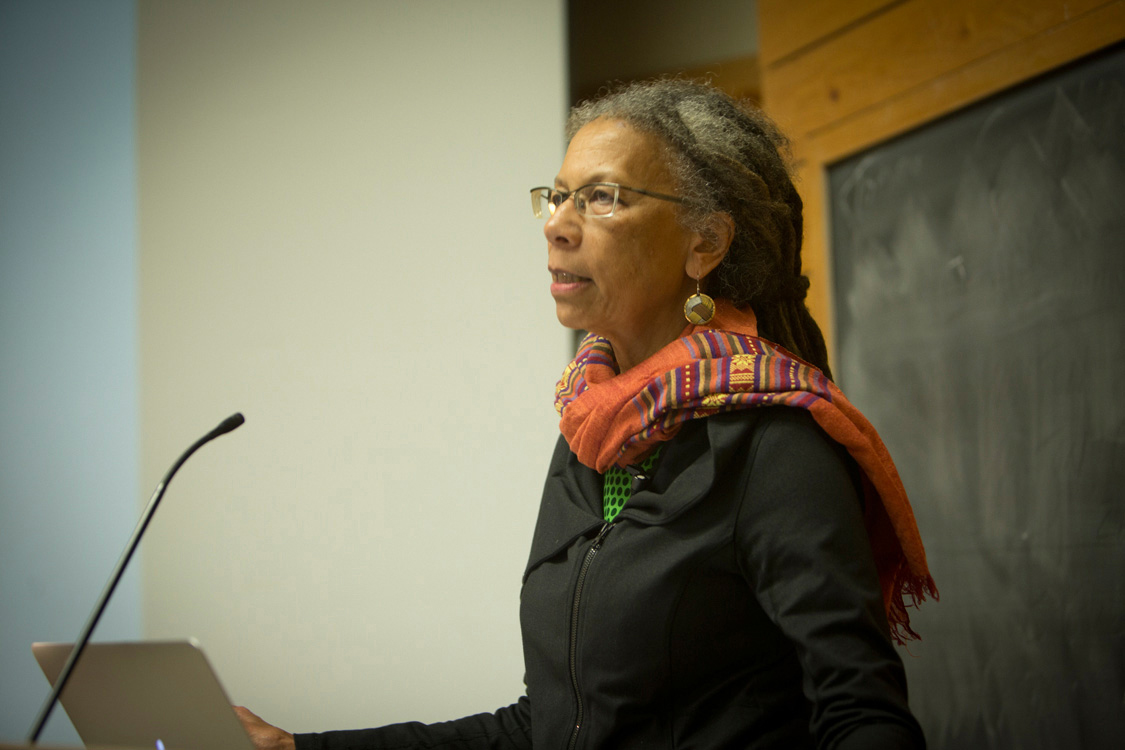Scholar details emergence of police-state tactics
By Amanda Bosworth

We are living in a prison industrial complex, according to Ruth Wilson Gilmore, professor of earth and environmental sciences at the City University of New York.
Gilmore gave the American Studies Program’s annual Krieger Lecture in American Political Culture March 3 on “Organized Abandonment and Organized Violence: Devolution and the Police.”
“Worldwide today, wherever inequality is deepest, the use of prisons as catch-all solutions to social problems prevails – nowhere as extensively as the United States,” said Gilmore. The United States has only 5 percent of the world’s population but 25 percent of its incarcerated population, she said, and if all prison sentences were commuted at President Obama’s current rate, it would take 50,000 years to empty the nation’s prisons.
When Obama took office, many Americans hoped he could reform the massive prison system “by executive fiat,” Gilmore said. In truth, most incarceration takes place at the state level and is beyond the power of the presidency. This, said Gilmore, is a sign of the broader process of “devolution” of governmental institutions: federal obligations have shifted to state and local governments and non-state agencies.
Gilmore called this the “anti-state state” and pointed to the anti-establishment tone of many recent political campaigns. To maintain this devolved, anti-state state, those in power have depended on mass criminalization to mark certain types of people as ineligible for social participation. The most common marker is race. The result has been “organized abandonment” of the most vulnerable and black communities, she said.
After World War II, many government agencies had to justify their continued existence in peacetime. Amid pressure to shrink, many institutions pursued a philosophy of “grow or die,” and militarization was often the result.
Gilmore offered Los Angeles in the 1980s as a case study: Police actions closely matched counterinsurgency tactics. Police swept “street terrorists” out of their neighborhoods in large numbers. It was not policing; it was “counterinsurgency run amok.”
In a dramatic shift, a new police commissioner tried another tack: crime suppression by providing social services that were denied to vulnerable communities with the devolution of state institutions. The LAPD flooded public housing projects and asked what the residents needed. Police brought in 800 pairs of bifocals, on-site diabetes screenings and $300,000 worth of computers for children to do their homework. The purpose was to “lower the level of perceived bias of the police” and strengthen the department’s mandate. Since this seems like a good way to build trust in poor neighborhoods, some observers promote this program as an alternative to police militarization.
But Gilmore warned that this “velvet glove” approach devolved into an “iron fist.”
For Gilmore, this “Community Safety Partnership” has a resemblance to American counterinsurgency campaigns in Iraq and Afghanistan. The first step in both programs was to “win the hearts and minds” of community matriarchs by supplying “precisely the goods and services that the neighborhood has been starved of.”
Gilmore argued, “The modern police system was designed to keep the marginalized in their place, and to warn the poor of a fate worse than poverty.” Since the Black Lives Matter movement began, the system faces a legitimacy crisis.
Gilmore’s lecture summarized a chapter she co-wrote with her husband, Craig Gilmore, from the forthcoming book “Policing the Planet: Why the Policing Crisis Led to Black Lives Matter,” available in May.
Amanda Bosworth, a Cornell doctoral student in history, is a writer intern for the Cornell Chronicle.
Media Contact
Get Cornell news delivered right to your inbox.
Subscribe